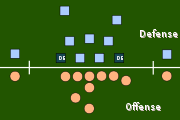
Defensive end
Encyclopedia

American football
American football is a sport played between two teams of eleven with the objective of scoring points by advancing the ball into the opposing team's end zone. Known in the United States simply as football, it may also be referred to informally as gridiron football. The ball can be advanced by...
and Canadian football
Canadian football
Canadian football is a form of gridiron football played exclusively in Canada in which two teams of 12 players each compete for territorial control of a field of play long and wide attempting to advance a pointed prolate spheroid ball into the opposing team's scoring area...
.
This position has designated the players at each end of the defensive line, but changes in formations have substantially changed how the position is played over the years. Eleven-time pro bowler and National Football League
National Football League
The National Football League is the highest level of professional American football in the United States, and is considered the top professional American football league in the world. It was formed by eleven teams in 1920 as the American Professional Football Association, with the league changing...
Hall of Famer Bruce Smith, usually considered one of the best defensive ends ever, is the all-time leader in career sacks with 200.
History
Early formations, with six- and seven-man lines, used the end as a containment player, whose job was first to prevent an "end run" around his position, then secondarily to force plays inside.When most teams adopted a five-man line, two different styles of end play developed: "crashing" ends, who rushed into the backfield to disrupt plays, and "stand-up" or "waiting" ends, who played the more traditional containment style. Some teams would use both styles of end play, depending on game situations.
Traditionally, defensive ends are in a three-point stance
Three-point stance
The three-point stance is a stance used by offensive and defensive linemen in American football as well as running backs. This stance requires one hand to touch the ground with the other arm cocked back to the thigh/hip region...
, with their free hand cocked back ready to "punch" the offensive lineman, or in a "two-point stance" like a linebacker
Linebacker
A linebacker is a position in American football that was invented by football coach Fielding H. Yost of the University of Michigan. Linebackers are members of the defensive team, and line up approximately three to five yards behind the line of scrimmage, behind the defensive linemen...
so they can keep containment. Some defensive ends play the position due to their size; they close down their gap so the running back
Running back
A running back is a gridiron football position, who is typically lined up in the offensive backfield. The primary roles of a running back are to receive handoffs from the quarterback for a rushing play, to catch passes from out of the backfield, and to block.There are usually one or two running...
has no hole to run through. Other ends play the position due to their speed and agility; they are used to rush the quarterback
Quarterback
Quarterback is a position in American and Canadian football. Quarterbacks are members of the offensive team and line up directly behind the offensive line...
. These ends can time the snap of the ball in order to get a jump on the rush.
Most of the time it is the job of the defensive end to keep outside or contain, which means that no one should get to their outside; they must keep everything to the inside. The defensive ends are fast for players of their size, often the fastest and smallest players on the defensive line. They must be able to shed blockers to get to the ball. Defensive ends are also often used to cover the outside area of the line of scrimmage, to tackle ball carriers running to the far right or left side, and to defend against screen pass
Screen pass
A screen pass is a type of play in American football. During a screen pass, a number of things happen concurrently in order to fool the defense into thinking a long pass is being thrown, when in fact the pass is merely a short one, just beyond the defensive linemen. Screens are usually deployed...
es. Since the creation of zone blitz
Zone blitz
The zone blitz is a common method of defensive pressure applied in American football, usually at the collegiate and professional levels. It exists in nearly limitless permutations, all of which share the common theme of confusing the offensive line by dropping pass-rushers into coverage, while at...
defenses in the late 1990s, defensive ends have sometimes been used in pass coverages, dropping back to cover routes run close to the line of scrimmage.
In the 3-4 defense
3-4 defense
In American football, the 3–4 defense is a defensive alignment consisting of three down linemen and four linebackers.The 3–4 defense declined in popularity over the years, but has found renewed use by modern professional and college football teams. The 3–4 defense is so named because it involves 3...
, defensive ends are used primarily as run stoppers and are much larger. Often, the position is played by a more agile or slightly undersized defensive tackle. Because of the increased popularity of the 3-4 defense, the value of a defensive tackle prospect that can possibly be used in this manner has increased.
See also
- Glossary of American footballGlossary of American footballThe following terms are used in American football and Canadian football, but see also the glossary of Canadian football.-0-9: A formation of the 4-3 defense featuring several dramatic shifts of personnel...

